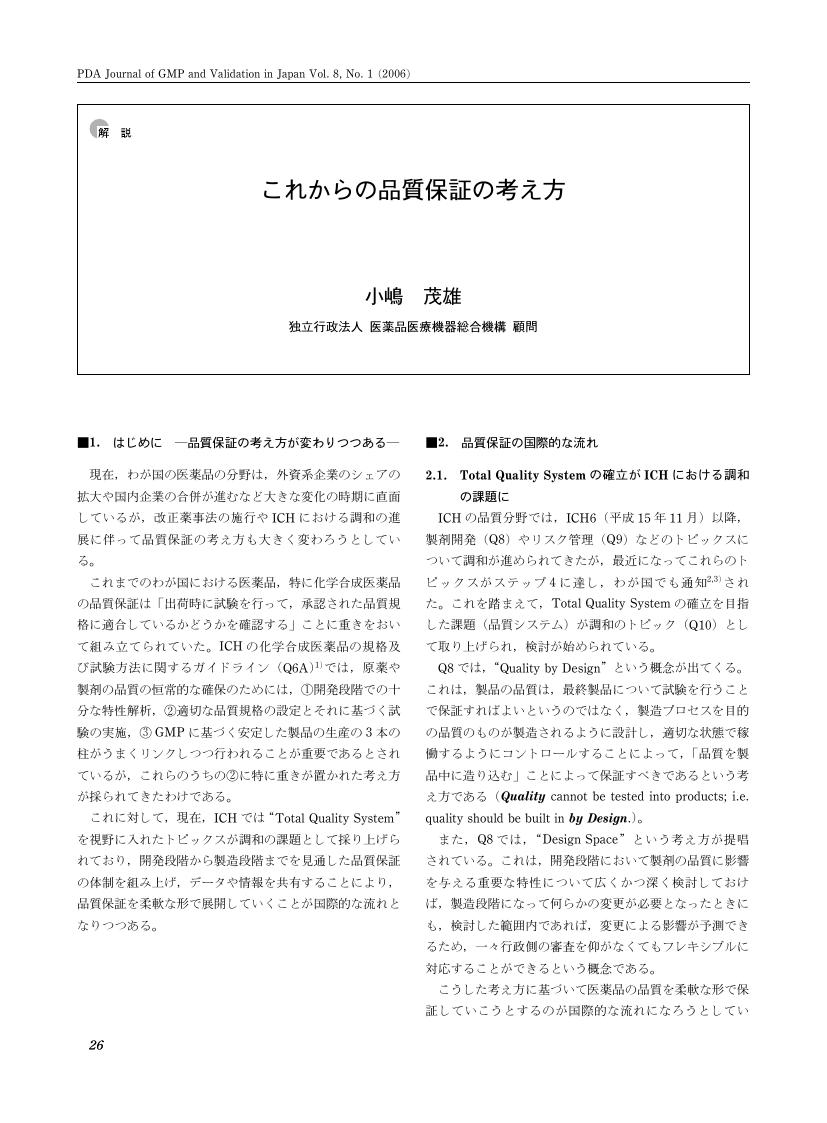1 0 0 0 OA これからの品質保証の考え方
- 著者
- 小嶋 茂雄
- 出版者
- 一般社団法人日本PDA製薬学会
- 雑誌
- 日本PDA学術誌 GMPとバリデーション (ISSN:13444891)
- 巻号頁・発行日
- vol.8, no.1, pp.26-38, 2006 (Released:2007-05-10)
- 参考文献数
- 8
1 0 0 0 OA 医薬品の品質保証に関する国際調和
- 著者
- 小嶋 茂雄
- 出版者
- 一般社団法人日本PDA製薬学会
- 雑誌
- 日本PDA学術誌 GMPとバリデーション (ISSN:13444891)
- 巻号頁・発行日
- vol.1, no.1, pp.18-35, 1999 (Released:2006-08-04)
- 参考文献数
- 5
- 被引用文献数
- 1
Harmonization of requirements for the regulation of drugs in the world is essential in order to make newly developed pharmaceuticals available all over the world as quickly as possible. For such purpose, ICH (International Conference on Harmonization of Technical Requirements for Registration of Pharmaceuticals for Human Use) has been organized and actively promoted by 6 parties from three regions (Japan: MHW & JPMA, USA: FAD & PhRMA, EU: CPMP & EFPIA). Quality topics on “Stability Testing, ” “Validation of Analytical Procedures” and “Impurities Testing” has already been finalized among three regions and implemented as the domestic guidelines by the regulatory authority of each member country. Other quality topics on “Specifications,” “GMP on Active Pharmaceutical Ingredients” and “Common Technical Documents” are now under discussion in ICH. In Japan, Revision of General Notices in Japanese Pharmacopoeia is proposed to cope with the concepts of “periodical/skip testing, ” in-process testing” and “parametric release” included in the Step 2 Draft of ICH Speicification Guideline. This article describes the concepts of ICH quality guidelines and their impacts on the regulation for drugs in Japan.
1 0 0 0 くつ皮膚炎の2例
- 著者
- 関東 裕美 細野 久美子 伊藤 正俊 石原 勝 中村 晃忠 小嶋 茂雄 鹿庭 正昭
- 出版者
- Meeting of Osaka Dermatological Association
- 雑誌
- 皮膚 (ISSN:00181390)
- 巻号頁・発行日
- vol.26, no.3, pp.664-671, 1984
ゴム添加剤に接触アレルギーを認めた16才, 男子学生のズック靴皮膚炎とformaldehydeに接触アレルギーを認めた51才, 女子会社員の革靴皮膚炎についてそれぞれの臨床, パッチテスト成績, 原因製品の分析結果について報告し, 靴皮膚炎のアレルゲンについて若干の考察を加えた.
- 著者
- 鹿庭 正昭 小嶋 茂雄 中村 晃忠
- 出版者
- 公益社団法人日本薬学会
- 雑誌
- 衛生化学 (ISSN:0013273X)
- 巻号頁・発行日
- vol.27, no.6, pp.391-398, 1981-12-31
- 被引用文献数
- 2 1
It has been recognized that lead poisoning in children in the United States is mainly caused by lead containing paints. In order to clarify whether children in Japan are safe from lead poisoning or not, we investigated lead contents in paints, paints covering pencils, wax crayons, water colors, and those in paint scrapings collected from the buildings of the National Institute of Hygienic Sciences and from its members' houses by the modified A.O.A.C. method. Consequently, considerable numbers of samples containing more than 0.06% of lead, which is the regulatory limit in the United States, were found : 10/31 in paints, 3/49 in paints covering pencils, 0/55 in wax crayons, 3/54 in water colors, and 19/68 in paint scrapings collected. From those analytical data, it was clarified that children in Japan are not always safe from lead poisoning and the further investigation should be undertaken to obtain more exact information.
